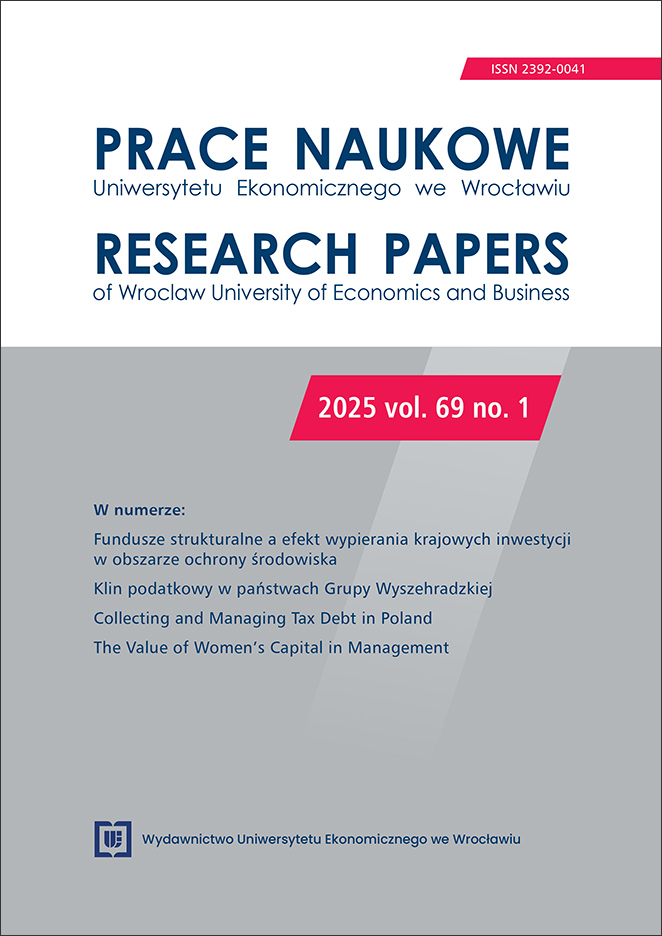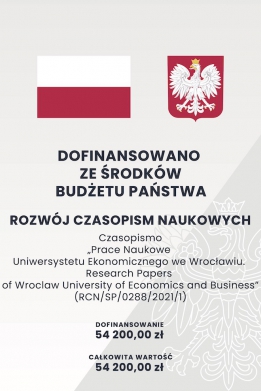Key Research Areas in Territorial Marketing from 2020 to 2025
DOI:
https://doi.org/10.15611/pn.2025.1.09Keywords:
territorial marketing, place marketing, city image, digital nomads, VOSviewerAbstract
Aim: The paper aims to present the identified key research areas in territorial marketing in 2020-2025.
Methodology: To identify relevant research materials, a literature analysis was conducted using the licensed database Web of Science. The keywords used for the search included territorial marketing and place marketing, as inserted by the authors. The analysis focused on articles published between 2020 and 2025 and only included materials written in English. A total of 240 scientific articles were exported in order to create a map illustrating the connections between the keywords within these articles. Keywords that appeared at least three times were selected for mapping process. Ultimately, 66 distinct keywords were identified, which formed five clusters representing different research areas.
Results: Based on the conducted mapping, key research areas in territorial marketing were identified and named, focusing on image communication and building the city's brand in recent years. The research indicates that this process should be based to a greater extent on distinguishing features referring to the identity of the place. It emphasizes the importance of residents' involvement in this process. Another important and current research trend is the analysis of marketing activities aimed at migrants, including digital nomads - temporary workers who often change location. This group plays a significant role in developing the local economy and promoting visited places via social media.
Implications and recommendations: This paper presents recommendations for three directions of future empirical research, the results of which can provide important data supporting the development of current research areas in territorial marketing.
Originality/value: Developing a synthetic review of contemporary issues related to place marketing enables scientists to identify key research problems. Systematic analysis of evolving issues facilitates the consolidation of knowledge and supports the dynamic development of this field, contributing to the improvement of place marketing strategies.
Downloads
References
Acharya, A., & Rahman, Z. (2016). Place Branding Research: A Thematic Review and Future Research Agenda. International Review on Public and Nonprofit Marketing, 13(3), 289–317. https://doi.org/10.1007/s12208-015-0150-7
Asnawi, A. (2021). Destination Images: Antecedents of City Marketing, Tourism Event, and Social Media Marketing Concept. Jurnal Perspektif Pembiayaan dan Pembangunan Daerah, 9(2), 171–186. https://doi.org/10.22437/ppd.v9i2.12742
Bonneau, C., & Aroles, J. (2021). Digital Nomads: A New Form of Leisure Class? In J. Aroles, F.-X. Vaujany, & K. Dale (Eds.), Experiencing the new world of work (pp. 157–177). Cambridge University Press. https://doi.org/10.1017/9781108865814.011
Casais, B., & Monteiro, P. (2019). Residents’ Involvement in City Brand Co-creation and Their Perceptions of City Brand Identity: A Case Study in Porto. Place Branding and Public Diplomacy, 15(4), 229–237. https://doi.org/10.1057/s41254-019-00132-8
Casais, B., & Poço, T. (2023). Emotional Branding of a City for Inciting Resident and Visitor Place Attachment. Place Brand Public Diplomacy, 19, 93–102. https://doi.org/10.1057/s41254-021-00231-5
Fibingier, E. (2021). Cyfrowy nomadyzm – nowy trend na rynku pracy. Rynek Pracy, 1-2, 19–31.
Florek, M. (2006). Podstawy marketingu terytorialnego. Wydawnictwo Akademii Ekonomicznej w Poznaniu.
Gertner, D. (2011). A (Tentative) Meta-Analysis of the ‘Place Marketing’ and ‘Place Branding’ Literature. Journal of Brand Management, 19(2), 112–131.
Ghafar, N., Ghani, N. M., & Adam, M. (2022). A review of the essence of city branding in enhancing the image and identity of a city. Planning Malaysia, 20(5), 66–78. https://doi.org/10.21837/pm.v20i24.1184
Gilboa, S. & Jaffe, E. (2021). Can One Brand Fit All? Segmenting City Residents for Place Branding. Cities, 116, 103287. https://doi.org/10.1016/j.cities.2021.103287
Glińska, E. (2017). Angażowanie interesariuszy w proces brandingu miasta – teoria versus praktyka. Zarządzanie Publiczne, 40(2), 33-49.
Gosik, B., & Żelazna-Jochim, D. (2018). Tworzenie pozytywnego wizerunku miejsca będącego elementem strategii marketingowej miasta – na przykładzie Tomaszowa Mazowieckiego. Zeszyty Naukowe WSH Zarządzanie, 3, 331–342.
Han, W., Tang, Y., & Wang, J. (2023). The Effect of Identity Salience on Residents’ Engagement with Place Branding during and Post COVID-19 Pandemic. Sustainability, 15(1), 357. https://doi.org/10.3390/su15010357
Hesari, E., Moosavy, S. M., Rohani, A., Kivi, S. B., Ghafourian, M., & Pour, B. (2020). Investigation the Relationship between Place Attachment and Community Participation in Residential Areas: A Structural Equation Modelling Approach. Social Indicators Research, 51, 921-941. https://doi.org/10.1007/s11205-020-02408-6
Huang, Y., J., Cheng, S., Yang, F., Q., & Chen, C. (2022). Analysis and Visualization of Research on Resilient Cities and Communities Based on VOSviewer. International Journal of Environmental Research and Public Health, 19, 7068.
Hunt, J. D. (1975). Image as a Factor in Tourism Development. Journal of Travel Research, 13(3), 1–7.
Kamiński, J. (2011). Istota i etapy marketingu terytorialnego. Studia Ekonomiczne i Regionalne, 4(1), 5–16.
Kavaratzis, M., & Florek, M. (2021). Special Section: The Future of Place Branding. Place Branding and Public Diplomacy, 17, 63–64. https://doi.org/10.1057/s41254-020-00197-w
Kobylińska, U. (2011). Współczesne wyzwania dla miejskich samorządów w zakresie kreowania wizerunku. Zeszyty Naukowe Uniwersytetu Szczecińskiego. Ekonomiczne Problemy Usług, 663(7), 61–71.
Kornak, A., & Rapacz, A. (2001). Zarządzanie turystyką i jej podmiotami w miejscowości i regionie. Wydawnictwo Akademii Ekonomicznej we Wrocławiu.
Kotler, Ph., & Barich, H. (1991). A Framework for Marketing Image Management. Sloan Marketing Review, 32(2), 94–104.
Kotler, Ph., Armstrong, G., Saunders, J., & Wong, V. (1999). Principles of Marketing. Prentice Hall.
Kotler, Ph., Rein, I., & Haider, H. (1993). Marketing Places: Attracting Investment. Industry, and Tourism to Cities, Regions and Nations. Macmillan.
Lhakard, P. (2022). Destination City for Digital Nomads in Thailand: A Case Study of Digital Nomad Community in Chiang Mai. Journal of Humanities and Social Sciences Studies, 4(1), 178–188. https://doi.org/10.32996/jhsss.2022.4.1.18
Mladenović, D. (2016). Concept of “Figure of Merit” for Place Marketing in Digital Nomadism Ages. In D. Petranová, J. Matš, & D. Mendelová, Marketing Identity Conference 2016 (pp. 393–403). Fakulta Masmediálnej Komunikácie.
Moilanen, T., & Rainisto, S. (2009). How to Brand Nations, Cities and Destinations: A Planning Book for Place Branding. Cromwell Press Ltd.
Olsson, K., & Berglund, E. (2010). Rethinking Place Marketing: A Literature Review. 50th Congress of the European Regional Science Association (pp. 1–20). European Regional Science Association.
Orel, M. (2021). Life Is Better in Flip Flops. Digital Nomads and Their Transformational Travels to Thailand. International Journal of Culture, Tourism and Hospitality Research, 15(1), 3–9.
Pasquinelli, C. Trunfio, Bellini, N., & Rossi, S. (2022). Reimagining Urban Destinations: Adaptive and Transformative City Brand Attributes and Values in the Pandemic Crisis. Cities, 124, 103621. https://doi.org/10.1016/j.cities.2022.103621
Silvanto, S., & Ryan, J. (2023). Rethinking Destination Branding Frameworks for the Age of Digital Nomads and Tele-commuters: An Abstract. In B. Jochims, & J. Allen (Eds.), Optimistic Marketing in Challenging Times: Serving Ever-Shifting Customer Needs (pp. 145–146). Springer.
Sokołowicz, M. E., Lewandowska-Gwarda, K., & Przygodzki, Z. (2022). Is the Grass Elsewhere Really Greener? A Study on the Place Marketing Activity of Polish Self-Governments. Bulletin of Geography. Socio-economic Series, 57(57), 7–21. https://doi.org/10.12775/bgss-2022-0020
Sztuk, A. (2022). Competitiveness of Cities in the Post-Pandemic Time: The Perspectives of Residents and Tourists. Ekonomia – Wroclaw Economic Review, 28(3), 129–144. https://doi.org/10.19195/2658-1310.28.3.8
Sztuk, A. (2023). Cities’ Attractiveness Factors from the Perspective of Digital Nomads. Scientific Papers of Silesian University of Technology. Organization and Management Series, 174, 322–336. https://doi.org/10.29119/1641-3466.2023.174.23
Szulce, H., Walkowiak, K., & Florek, M. (2004). Segmentacja jako podstawa zróżnicowania działań marketingowych. Acta Universitatis Lodziensis. Folia Oeconomica, 179(1), 273–284.
Tran, N. L., & Rudolf, W. (2022). Social Media and Destination Branding in Tourism: A Systematic Review of the Literature. Sustainability, 14(20), 13528. https://doi.org/10.3390/su142013528
Van Hoose, K., Hoekstra, M., & Bontje, M. (2021). Marketing the Unmarketable: Place Branding in a Postindustrial Medium-Sized Town. Cities, 114, 103216. https://doi.org/10.1016/j.cities.2021.103216
Vuignier, R. (2017). Place Branding & Place Marketing 1976–2016: A Multidisciplinary Literature Review. International Review on Public Nonprofit Marketing, 14, 447–473.
Wang, X., Lai, I. K. W., & Song, B. (2021). Place Attachment and Affinity: Turning the Mainland Chinese Students into “Word--of-Mouth Champions”. Journal of Hospitality and Tourism Insights, 6(2), 385–403.
Wassler, P., Wang, L., & Hung, K. (2021). Residents’ Power and Trust: A Road to Brand Ambassadorship? Journal of Destination Marketing & Management, 19, 100550. https://doi.org/10.1016/j.jdmm.2020.100550
Widera, W. (2021). Attracting and Pre-Integrating Migrants Using Digital Media in the Local Labour Market. Communication Today, 12(1), 28-42.
Wiśniewska, A. (2011). Kampanie reklamowe w kształtowaniu wizerunku miasta. In A. Grzegorczyk, & A. Kochaniec (Eds.), Kreowanie wizerunku miast (pp. 86–104). Wydawnictwo Wyższej Szkoły Promocji.
Yu, E., & Kim, J. (2020). The Relationship between Self-City Brand Connection, City Brand Experience, and City Brand Ambassadors. Sustainability, 12(3), 982. https://doi.org/10.3390/su12030982
Zenker, S., & Beckmann, S. (2013). My place Is Not Your Place – Different Place Brand Knowledge by Different Target Groups. Journal of Place Management and Development, 6(1), 6–17.
Zenker, S., & Seigis, A. (2012). Respect and the City: The Mediating Role of Respect in Citizen Participation. Journal of Place Management and Development, 5(1), 20–34.
Downloads
Published
License
Copyright (c) 2025 Aleksandra Sztuk

This work is licensed under a Creative Commons Attribution-ShareAlike 4.0 International License.
Accepted 2025-04-04
Published 2025-05-28









